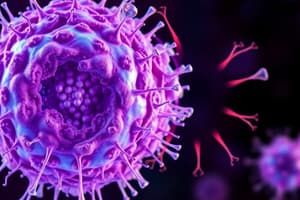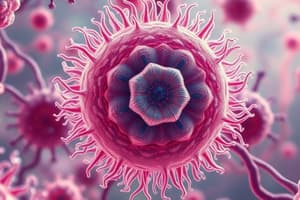Podcast
Questions and Answers
What did Robert Hooke observe when he first examined cork samples?
What did Robert Hooke observe when he first examined cork samples?
- Cells in animals
- Mitochondria
- Small cavity structures (correct)
- Nucleus of cells
Which of the following statements is part of the cell theory?
Which of the following statements is part of the cell theory?
- All organisms are made up of cells. (correct)
- All cells contain a nucleus.
- Cells can arise spontaneously from non-living matter.
- Cells are not the fundamental unit of life.
What is the primary difference between prokaryotic and eukaryotic cells?
What is the primary difference between prokaryotic and eukaryotic cells?
- Eukaryotic cells lack a cell membrane.
- Eukaryotic cells contain organelles. (correct)
- Prokaryotic cells have a nucleus.
- Prokaryotic cells have internal compartmentalization.
Which statement correctly describes the chromosome characteristics of prokaryotic cells?
Which statement correctly describes the chromosome characteristics of prokaryotic cells?
What role do hopanoids play in prokaryotic cell membranes?
What role do hopanoids play in prokaryotic cell membranes?
Which lipid is primarily associated with animal cell membranes to impact membrane fluidity?
Which lipid is primarily associated with animal cell membranes to impact membrane fluidity?
What is the function of cholesterol in cell membranes?
What is the function of cholesterol in cell membranes?
Phospholipids in cell membranes are characterized by having which of the following?
Phospholipids in cell membranes are characterized by having which of the following?
What characteristic of phospholipids allows them to form bilayers in water?
What characteristic of phospholipids allows them to form bilayers in water?
Which type of lipid structure is formed by phospholipids with small bulky heads and two hydrophobic tails?
Which type of lipid structure is formed by phospholipids with small bulky heads and two hydrophobic tails?
How does cholesterol impact the fluidity of the cell membrane?
How does cholesterol impact the fluidity of the cell membrane?
What determines the lateral movement of lipids within the membrane?
What determines the lateral movement of lipids within the membrane?
What is a key role of integral membrane proteins?
What is a key role of integral membrane proteins?
Which of the following statements about peripheral membrane proteins is true?
Which of the following statements about peripheral membrane proteins is true?
What type of interaction stabilizes the membrane's structure?
What type of interaction stabilizes the membrane's structure?
What is a significant characteristic of membranes that contribute to their fluid nature?
What is a significant characteristic of membranes that contribute to their fluid nature?
Flashcards are hidden until you start studying
Study Notes
1665: Robert Hooke and Cells
- Robert Hooke built a microscope to examine thin sections of dried cork from plants.
- Hooke observed that cork samples were made up of small cavities.
- He was the first to name these cavities "cells".
Cell Theory
- All organisms are made up of cells.
- The cell is the fundamental unit of life.
- Cells come from preexisting cells.
Prokaryotic and Eukaryotic Cells
- Cells are classified as prokaryotic or eukaryotic.
- Prokaryotic cells lack a nucleus and have no internal compartmentalization.
- Eukaryotic cells have a nucleus and internal membrane-bound organelles.
- Prokaryotes belong to the Domain Bacteria and Domain Archaea.
- Eukaryotes belong to the Domain Eukarya.
Prokaryotes vs. Eukaryotes
- Prokaryotes: no nucleus (nucleoid region), haploid chromosomes, transcription in cytoplasm, translation location in cytoplasm, small size (1-2 micrometers), high surface area to volume ratio, no organelles, cell membrane hopanoid additions.
- Eukaryotes: nucleus, diploid chromosomes, transcription in nucleus, translation location in cytoplasm, larger size (10-20 micrometers), low surface area to volume ratio, contains organelles (mitochondria, chloroplasts), cell membrane sterols (e.g. cholesterol).
Hopanoids
- Hopanoids are located in the membranes of bacteria.
- Hopanoids modulate the fluidity of the membranes by interacting with the phospholipids to form a highly ordered membrane bilayer which increases the rigidity of the membranes.
Cholesterol
- Cholesterol is found in many animal cell membranes.
- Cholesterol has both polar and nonpolar regions and associates into cell membranes.
- Cholesterol can impact membrane fluidity.
All Cells Are Defined by a Cell Membrane
- The major lipids found in the cell membranes are phospholipids.
- Phospholipids have a hydrophobic tail (nonpolar region) and a hydrophilic head (polar region).
- Phospholipids are amphipathic.
Lipid Structures: Micelle and Bilayer
- Micelles are formed by phospholipids with large bulky heads and a single hydrophobic tail.
- Bilayers and liposomes are formed by phospholipids with small heads and two hydrophobic tails.
Lipid Structures: Liposome (or lipid vesicle)
- When in water, phospholipids spontaneously form a liposome where polar heads and nonpolar tails associate with one another in a bilayer.
- Membranes are self-healing because they will spontaneously reform.
Membranes Are a Fluid Mosaic
- Lipids and proteins are found in the membrane, forming a mosaic.
- Lipids are able to move laterally within the membrane.
- Lipid movement is affected by the nature of the phospholipid tails.
- Saturated tails are straight and pack tightly.
- Unsaturated tails are bent and pack loosely, increasing fluidity.
Cholesterol and Fluidity
- Cholesterol acts like a “buffer” for membrane fluidity.
- At low temperatures, cholesterol prevents phospholipid tails from packing tightly and increases fluidity.
- At high temperatures, cholesterol prevents phospholipids from moving too freely and reduces fluidity.
Proteins in the Membrane
- Proteins of the membrane include:
- Transporters that move ions and molecules.
- Receptors that allow the cell to receive signals from the environment.
- Enzymes that catalyze chemical reactions in the cell.
- Anchors that attach to other proteins such as actins or cytoskeleton that help to maintain cell structure and shape.
Integral and Peripheral Proteins
- Integral membrane proteins are permanently associated with the membrane and can cross the entire membrane.
- Peripheral membrane proteins are temporarily associated with either side of the membrane.
Studying That Suits You
Use AI to generate personalized quizzes and flashcards to suit your learning preferences.




